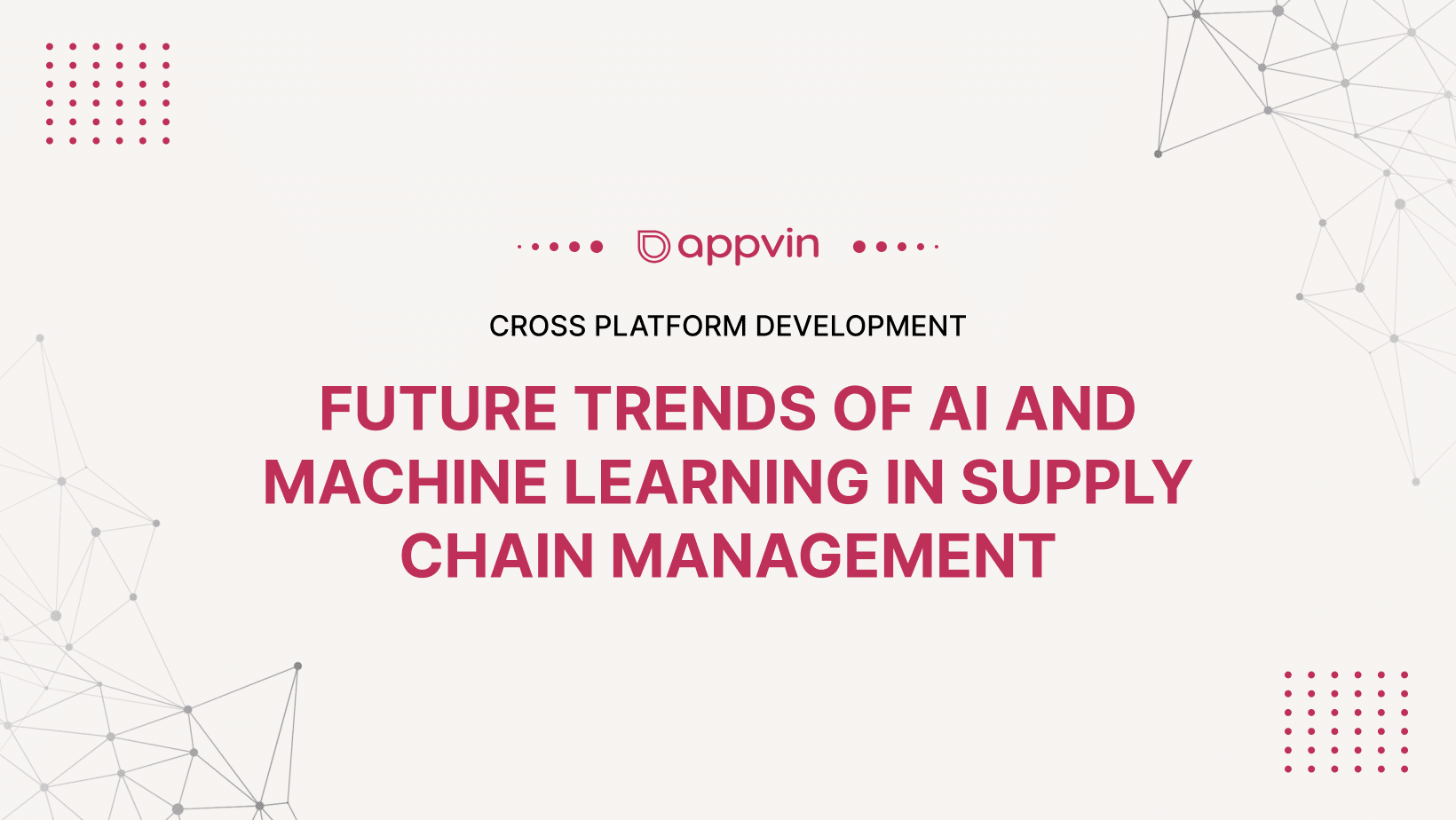AI and machine learning in the supply chain help retailers, suppliers, and distributors make important changes needed during the pandemic in the supply chain. Machine Learning greatly enhances supply chain operations by improving cost reduction, risk control, forecasting accuracy, timely deliveries, and service quality. Therefore, machine learning has emerged as a significant advancement in supply chain management.
Handling a large number of suppliers, warehouses, and logistics can be very challenging in supply chain management. Furthermore, and most significantly, machine learning and AI will be there to assist you throughout your entire supply chain management process. ML algorithms predict demand with precision, improve logistics management, simplify paperwork processes, and automate manual tasks effectively.
As a result, you will gain full transparency into your supply chain. Nevertheless, throughout the entire process, this resulted in enhanced productivity, decreased operational costs, and strengthened ability to handle disruptions.
Logistics companies leverage artificial intelligence and machine learning for advanced data analytics, aiming to enhance performance and customer satisfaction. Gartner reports that approximately 50% of supply chain operations may be powered by AI-based software with advanced analytics. Machine-studying-primarily based software allows for automated course building and higher demand forecasting, reducing fees and improving operations.
This article explores the benefits of integrating machine learning technology into supply chain optimization and highlights key considerations for leveraging this revolutionary technology in businesses.
Benefits of integrating machine learning technology into supply chain optimization
AI-Powered Demand Forecasting
Demand forecasting helps companies predict future demand for their products or services based on historical sales, market trends, and customer behavior.
Forecasting essential goods and services is crucial for logistics and supply chain management. Consequently, AI and machine learning in the supply chain algorithms in transportation planning analyze historical data and market trends to predict future demand, thereby enhancing delivery efficiency through route and resource optimization.
In optimizing warehouse space, AI predicts product demand to efficiently manage storage. AI tools in supplier collaboration and production planning leverage order data and supplier performance metrics to forecast component demand, thereby streamlining production processes.
AI algorithms also assist in minimizing stockouts and efficiently handling returned products in inventory replenishment and reverse logistics forecasting. Furthermore, AI and machine learning in the supply chain examines international trade information to enhance customs approval processes and delivery paths for cross-border logistics.
Importance of accurate demand forecasting in supply chain operations
The close relationship between demand forecasting and inventory management allows companies to match inventory levels to anticipated demand. Accurate forecasting helps businesses avoid oversales or stockouts. Having too many inventories increases storage costs, depreciates, and reduces prices, ultimately leading to losses.
Nevertheless, running out of inventory can result in unhappy customers, missed sales opportunities, and product shortages. Companies can enhance inventory quality, lower shipping expenses, and minimize excess inventory risks through precise demand forecasting.
How AI Enhances Demand Forecasting Accuracy
In a digitally pervasive era, inventory control is rapidly evolving. Conventional forecasting strategies, known as “call-for-pushed” techniques, rely on long-term data to predict future inventory needs but often fall short in today’s dynamic market. Understocking when there is a sudden drop in demand, overstocking or unexpected surges. Such differences create complexity and can be financially stressful for businesses.
Enter AI-enabled demand forecasting—a game-changing approach that combines technology and strategy, improving logistics operations.
In demand forecasting, AI and machine learning in the supply chain use advanced algorithms to refine and optimize the forecasting process. Instead of just considering past sales data, it casts a wide net—including current market trends, digital footprint on social media, Internet searches, and more.
Time series analysis and predictive modeling
Machines excel at reading huge amounts of historical data, spotting habitual styles, and gaining valuable insights. Moreover, recurrent neural networks (RNNs) and long short-term memory (LSTM) models excel at capturing time-structured patterns, making them highly valuable for time-series forecasting tasks.
Machine learning algorithms proficiently analyze extensive historical time series data to detect patterns, trends, seasonal features, and other dependent variables.
Methods such as the integrated moving average (ARIMA) model are particularly suitable for time series forecasting. RNN and LSTM are potent neural networks for sequential data, adept at capturing temporal patterns in-demand data and forming intricate nonlinear relationships between past and future prices for precise forecasts.
The ARIMA model incorporates autoregressive (AR), integrated (I), and moving average (MA) components, enabling improved modelling and prediction of time series data with trends, seasons, and other patterns. Furthermore, machine learning algorithms such as decision trees, random forests, and gradient-boosting models can forecast demand by utilizing historical data and adapting to future objectives.
Incorporating external data sources for contextual insights
While historical demand information is important, AI and machine learning in the supply chain systems improve forecasting accuracy by incorporating multiple external data sources, such as:
- Economic Indicators: Macroeconomic factors like GDP growth, inflation, consumer confidence, and employment data influence consumer income and demand.
- Demographic Data: Trends in age, income, and demographics provide insights into potential demand changes in different markets.
- Weather and Seasons: Climate and seasonal shifts impact demand for items like heating, cooling systems, and seasonal clothing.
- Consumer Sentiment Analysis: Analyzing media, online searches, and product inquiries helps AI gauge consumer preferences and upcoming trends affecting demand.
- Competitor Insights: Understanding competitors’ pricing, promotions, and new launches drives demand shifts, guiding pricing and marketing strategies.
- Significant Events: Events like holidays, sports competitions, or cultural celebrations impact demand, making event data essential for accurate forecasting.
Conclusion
As supply chains become more complex, businesses need to incorporate machine learning and AI. However, AI and machine learning in the supply chain help predict demand, optimize resources, manage logistics, and mitigate supply chain risks, enhancing efficiency, cutting costs, and improving customer satisfaction.
However, effectively implementing AI and machine learning in the supply chain requires a comprehensive approach. Companies must invest in data infrastructure recruit talent with expertise in this area and promote decision-making based on data. Collaboration among teams like supply chain managers, data scientists and IT professionals is essential, for introducing and embracing AI and machine learning in the supply chain solutions.
FAQs
What is supply chain optimization?
Supply chain efficiency involves enhancing the effectiveness of various supply chain activities, including purchasing, manufacturing, inventory management, and distribution.
How does machine learning contribute to supply chain optimization?
Machine learning technologies help retailers, suppliers, and distributors make important changes needed during the pandemic in the supply chain. Machine Learning greatly enhances supply chain operations by improving cost reduction, risk control, forecasting accuracy, timely deliveries, and service quality.
How does AI improve demand forecasting accuracy?
In demand forecasting, AI uses artificial intelligence (AI) to refine and optimize the forecasting process. Instead of just considering past sales data, it casts a wide net—including current market trends, digital footprint on social media, Internet searches, and more.
What are the overall advantages of the use of AI in demand forecasting for supply-chain management?
Overall benefits include improved forecasting accuracy, enhanced inventory management, reduced costs, increased customer satisfaction, and greater adaptability to market changes.
What is time collection evaluation inside the context of a call for forecasting?
Machine learning excels at processing large volumes of historical data, identifying recurring patterns, and extracting valuable insights. However, recurrent neural networks (RNNs) and long short-term memory (LSTM) networks are particularly effective at capturing time-based patterns, making them valuable for time-series forecasting.







